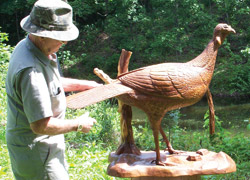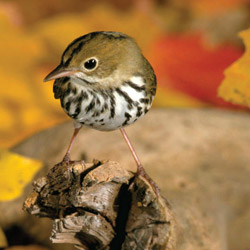Now the journey is part of the destination.
Formed when glacial melt-waters cascaded down the river valley more than 15,000 years ago, the Illinois River is the lifeblood of our ecosystem and the source of central Illinois’ distinctive personality. From Native Americans to French explorers, the river has served as a platform for commerce, transportation and recreation. Runaway slaves sought freedom along its banks, and steamboat captains followed the Illinois to the Mississippi, all the way to New Orleans. Today, the historic course is available for exploration through a different means.
A Living Museum
The Illinois River Road National Scenic Byway follows routes along both sides of the river, uniting more than 100 nature-based destinations throughout this beautiful valley in a 291-mile circular path stretching from Ottawa in the north to Havana in the south. With a wealth of opportunities for historic exploration, scenic views and outdoor activities, the Illinois River Road is an ideal way to enjoy much of what the state has to offer.
Just 126 routes in 44 states are designated by the U.S. Department of Transportation Federal Highway Administration (FHWA) as America’s Byways. To achieve byway designation, the route must exhibit at least one of six qualities for visitors to experience—nature, recreation, scenery, culture, history and archaeology. There are seven byways in Illinois: the Great River Road, the Historic National Road, Historic Route 66, Lincoln Highway, Meeting of the Great Rivers Scenic Route, the Ohio River Scenic Byway, and of course, the Illinois River Road.

The Illinois River Road received federal byway designation in 2005 as a result of the collaboration of 10 counties, more than 40 communities and many other partners. Like all national byways, it offers visitors the opportunity to slow down, pull off the interstate and experience the “real, authentic America.” It is a “living museum without walls” that enhances the natural, scenic, historic and cultural experience of the region, while providing unique recreational and educational experiences and sustaining local communities’ economies and quality of life.
Layers of History and Biodiversity
The Illinois River Road National Scenic Byway exhibits all six of the intrinsic qualities of byways, but its focus to date has been primarily on nature. Byway Director Anaise Berry explained the plan to emphasize some of its other qualities in the future. “We plan to begin interpreting the Byway region’s history and archaeology in 2010,” she said. “This will be a great opportunity for Byway communities to promote their history and unique qualities to the visiting public.”
Brian “Fox” Ellis is a storyteller, performer and educator whose work takes him up and down the Illinois River Road. “There are so many rich layers of history here, that every time I turn around, I learn something new about the importance of the Illinois River Road,” he exclaims, “from the modern barge traffic that literally feeds the world to the ancient mound builders who used the river to trade goods as far away as the Rockies and the Gulf Coast.”
The Byway is a convenient way to enjoy the rich diversity of nature and wildlife of central Illinois. This spring, Ellis performed at birding festivals in New Mexico and Vermont, but explained, “I did not have to travel that far to see the most spectacular variety of birds, because over 200 species use the Illinois River for their annual migrations.”
More than 20 distinct natural environments make up the rich fabric of the Illinois River Valley, including oak/hickory savannas, sand prairies, marshes, upland grassland communities, bottomland hardwood forests and open backwater lakes. These habitats house an incredible array of biodiversity, from rare species of birds to box turtles and white-tailed deer. The river valley also features an abundance of crops and luscious countryside. The livelihood of many Illinois residents, of course, depends on these crops; many earn their incomes from the fields of corn, soybeans and fresh produce that stretch across the region.
In the past, human activities have harmed this natural heritage and decreased wildlife populations, but ongoing restoration projects have brought new species to the area and revived the populations of species that were once declining. Projects initiated through the Clean Water Act have improved water quality, while other conservation projects have reclaimed wetlands and prairie habitat. Ducks Unlimited and The Nature Conservancy are two of the principal organizations involved in vast restoration projects along the Illinois River.
With an abundance of recreational opportunities, residents and tourists alike can immerse themselves in this natural beauty. There are tremendous opportunities for camping, picnicking, fishing, hiking, horseback riding, boating and hunting all along the River Road.
Showing the Way
State officials recently created new signage for the Byway with the intention of making different stops along the river more visible. These sites are excellent ways to break up long drives through the state. The Illinois Department of Transportation is currently at work putting nearly 200 new signs along the Byway, replacing the old signs that are currently in place.
“Gateway kiosks and interpretive signage at various waypoint sites will be placed over the coming months,” said Berry. “We’ll be developing an audio/video tour of the Byway, as well as marketing programs and pieces designed to target interest- and site-specific needs (ie. boaters, bikers, hikers, birders, etc.). We will be conducting a feasibility study to explore extension of the Byway to the north (possibly to Lake Michigan) and/or to the south (Meeting of the Great Rivers NSB and Great River Road NSB).
The Byway also has great potential to spur the development of spin-off businesses, from canoeing outfits and tour organizers to bed and breakfasts, restaurants and arts-related businesses. We will be conducting a study to examine the types and numbers of ‘Byway businesses’ currently existing throughout the corridor,” added Berry, “and look at developing our business base to add to the visitor’s overall experience.”
A jewel of the Midwest, the Illinois River Road National Scenic Byway is a showcase for the natural beauty that encompasses the region. It is also a great tourism tool. “As its infrastructure develops,” noted Berry, “the Byway will be a significant catalyst for visitor-based economic development for our region, as well as creating a sense of pride for those of us who live and work here.” iBi
 Nature-Based Tourism
Nature-Based Tourism
Nature-based tourism is much like it sounds. More than ever, travelers are seeking out natural areas and outdoor activities for their vacations and trips. In fact, nature-based tourism is considered the fastest-growing tourism segment.
Amidst the hustle and bustle of today’s world, many tourists are taking comfort in the serenity of the outdoors and the direct experience of plant and animal wildlife. Those looking for discovery and adventure often plan activities such as hiking, fishing, camping, backpacking and biking. Environmental awareness and spiritual growth are additional benefits of this approach.
This type of tourism has also proven to greatly benefit the economy. A report from the U.S. Fish and Wildlife Service claims that expenditures for wildlife watching are equivalent to the revenues generated from all spectator sports, amusement parks and arcades, non-hotel casinos, bowling centers and skiing facilities combined. According to the report, the direct expenditures of wildlife watchers generated $122.6 billion in 2006, resulting in more than one million jobs, federal tax revenue of $9.3 billion, and state and local tax revenues of $8.9 billion. These expenditures included items such as cameras and binoculars, as well as trip-related expenses such as lodging, transportation and food.
View the report, Wildlife Watching in the United States: The Economic Impacts on National and State Economies in 2006, online at library.fws.gov/nat_survey2006_economics.pdf.


